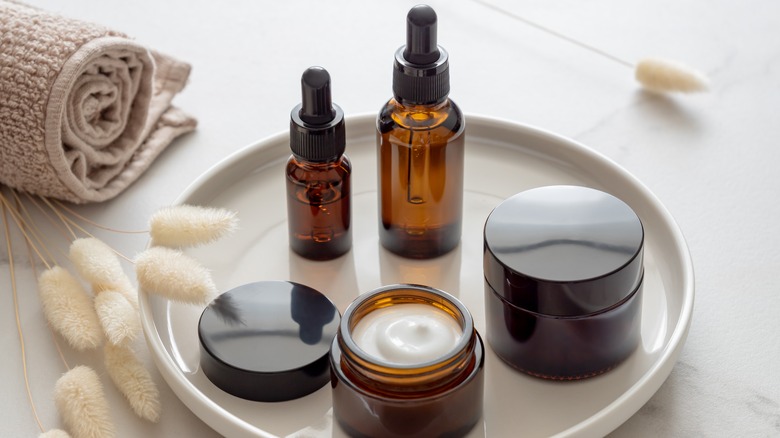Is It Safe To Combine Hyaluronic Acid And Retinol?
We may receive a commission on purchases made from links.
With such a wide variety of skincare advice available, it can be tricky to decide exactly what to put on your skin. Ingredients like hyaluronic acid and retinol are celebrated as star ingredients, but when you're trying to decide which one to go with (along with every other skin product you've been advised to use), it's easy to get confused. The logical move is to combine skincare products and incorporate them all into your routine. But does mixing these active ingredients together render them ineffective? Worse, can it actually harm your skin?
These concerns aren't baseless; skin gurus confirm that there are several active skincare ingredients that should never be mixed. Combining retinol and alpha hydroxy acid, for example, is likely to result in skin irritation (via Everyday Health). In general, doubling up on any two products that share the same active ingredients can aggravate your skin. That said, combining two skin products that have different properties can give your skin a double line of defense against the signs of aging, provided they complement each other. When it comes to mixing hyaluronic acid and retinol, experts across the board share the same opinion.
What the experts say
Hyaluronic acid is a natural substance found in your skin, connective tissue, and eyes (via Healthline). When used topically as part of a skincare routine, hyaluronic acid hydrates the skin, reducing the appearance of wrinkles. It can also relieve skin redness and dermatitis. Similarly, retinol is a compound derived from vitamin A that boosts cell turnover (via The Skin Spot). When incorporated into a skincare routine, topical retinol can reduce signs of aging, clear pores, brighten skin tone, and decrease hyperpigmentation. Both these active ingredients have a long list of benefits, and the good news is you don't have to choose between them; it's totally safe to combine hyaluronic acid and retinol!
Not only are hyaluronic acid and retinol okay to use together in your skincare routine, but combining them may also reduce the chance of unwanted side effects, such as skin irritation (via Apostrophe). Retinoids, such as retinol, can cause dryness in the skin, which leads to flaking and irritation. Because hyaluronic acid is a moisturizer, it can combat these side effects by adding a dose of hydration to the skin. Using retinol and hyaluronic acid together is perfectly fine, and the best way to combine them is to layer them onto your skin.
How to combine hyaluronic acid and retinol
Skin Pharm recommends applying retinol before hyaluronic acid, as retinol is at its most effective when it has the chance to sink into the pores. Begin by washing your face as you normally would with a cleanser, and then dry your face. While hyaluronic acid should be applied to damp skin, retinol should be applied to dry skin to reduce the likelihood of negative side effects. Apply retinol to the areas of your face showing the most signs of aging and allow it to set. Then, go ahead and apply your hyaluronic acid. If your hyaluronic acid is in the form of a serum, follow this with a moisturizer.
Dermstore explains that retinol can be used every day, morning and night (after an adjustment period during which you apply low and less frequent doses). However, never forget to finish your morning skincare routine with SPF, especially when using retinol. The Skin Cancer Foundation explains that the new skin developed by retinol is thin and shouldn't be exposed to direct sunlight. Furthermore, sunlight can diminish the skin benefits of retinol. But if you do choose to use retinol in the morning, remembering SPF is crucial to reduce sun sensitivity and the risk of developing skin cancer.
Hyaluronic acid and retinol are both effective ingredients that are worth incorporating into your skincare routine, and using them together in this way is not only acceptable but actually encouraged by skin experts.


